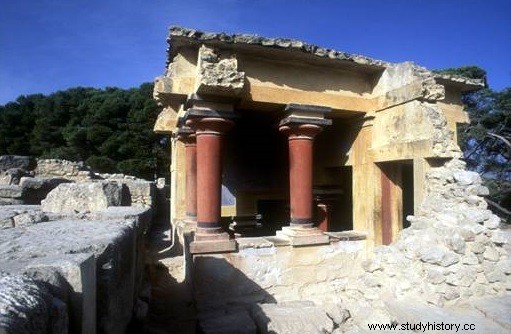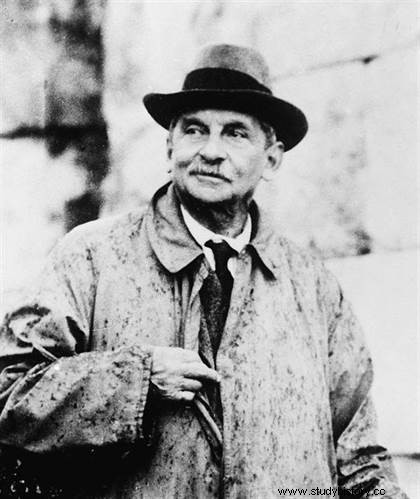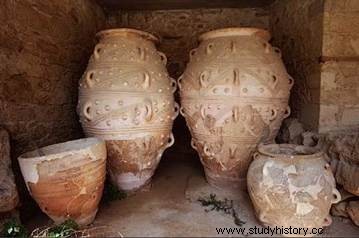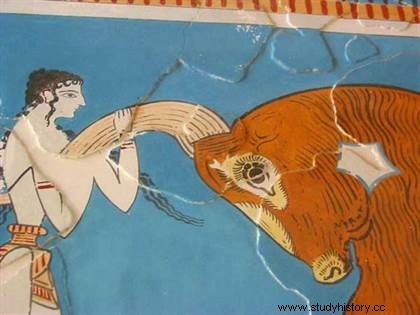 The Minoan civilization , located in the Bronze Age, is considered the first in Europe. It flourished in Crete in the Aegean Sea and is the source of many myths and legends of Greek antiquity. She knows how to write, develops a refined fresco art, where a unique sweetness of life appears, and builds magnificent palaces such as that of Knossos. The Minoan reached its peak in the 2nd millennium BC at Knossos, Phaïstos and Malia in particular. In 1900, the British archaeologist Evans unearthed the Minoan palace of Knossos and immediately began its restoration, with methods that would arouse many controversies. The labyrinthine shape of the palace evoking the legendary King Minos, Evans will give his name to the civilization that built this building.
The Minoan civilization , located in the Bronze Age, is considered the first in Europe. It flourished in Crete in the Aegean Sea and is the source of many myths and legends of Greek antiquity. She knows how to write, develops a refined fresco art, where a unique sweetness of life appears, and builds magnificent palaces such as that of Knossos. The Minoan reached its peak in the 2nd millennium BC at Knossos, Phaïstos and Malia in particular. In 1900, the British archaeologist Evans unearthed the Minoan palace of Knossos and immediately began its restoration, with methods that would arouse many controversies. The labyrinthine shape of the palace evoking the legendary King Minos, Evans will give his name to the civilization that built this building.
The Minoan civilisation, from legend to archaeological discoveries
The Minoan civilization owes its name to King Minos, legendary Cretan ruler, whose fleet the ancient Greeks claimed dominated the Aegean world. A British archaeologist, Sir Arthur John Evans carried out archaeological digs in Crete around 1900 and unearthed the palace of Knossos. This discovery highlights the existence of the Minoan civilization. Many see in the palace of Knossos the famous labyrinth where the Minotaur, according to legend, was locked up. This is the famous episode of Theseus, who, with the help of Ariadne's thread, will eventually find the exit from the labyrinth.
 Evans is carrying out important and controversial restoration work at Knossos, which is similar to a reconstruction. The most important of the Minoan palaces consisted of a maze of multi-storey buildings arranged around a central courtyard. Inside, the rooms were decorated with refined decorations and frescoes. The configuration of the premises suggests that the palace had a religious and not residential vocation, although it includes a "throne room". It could even have served as a warehouse. Shortly after Evans, the Italian Luigi Pernier discovered in another palace a clay disc covered with hieroglyphs. The authenticity of the Phaistos disc is still debated today, its dating not having been possible.
Evans is carrying out important and controversial restoration work at Knossos, which is similar to a reconstruction. The most important of the Minoan palaces consisted of a maze of multi-storey buildings arranged around a central courtyard. Inside, the rooms were decorated with refined decorations and frescoes. The configuration of the premises suggests that the palace had a religious and not residential vocation, although it includes a "throne room". It could even have served as a warehouse. Shortly after Evans, the Italian Luigi Pernier discovered in another palace a clay disc covered with hieroglyphs. The authenticity of the Phaistos disc is still debated today, its dating not having been possible.
A trading Minoan world
It was agriculture that allowed the rise of the Minoans. They exploited as widely as possible the fertile soils at their disposal, especially in the valleys. Wheat, viticulture and olive growing were already mastered. Wheat production was satisfactory and made it possible to feed the population. The surpluses of olive oil and wine were used for trade:the Minoans exchanged these foods for raw materials, for example copper, with peoples living on the continent. We had an exchange system based on barter. Wool was produced by the Cretans, on the high plateaus. This resulted in a fabric that was exported to Egypt, with which the Minoans had intense commercial relations.
 Also, we can note the presence of work around ceramics in Crete. In the ancient Minoan palaces, as at Knossos, agricultural produce was stored in pithoi, monumental jars with narrow necks and equipped with small handles and stored in stores. Some pithoi could contain several thousand liters of wine or olive oil.
Also, we can note the presence of work around ceramics in Crete. In the ancient Minoan palaces, as at Knossos, agricultural produce was stored in pithoi, monumental jars with narrow necks and equipped with small handles and stored in stores. Some pithoi could contain several thousand liters of wine or olive oil.
The discovery of various palaces by archaeologists shows that around 2000 BC, Crete was very prosperous. The palace of Knossos bears witness to this, as well as those of Phaistos and Chania. Many elements indicate that the Mediterranean trilogy was already in place, with warehouses containing the products of cereal growing, viticulture and finally olive growing. These products were intended to be paid to the king by the peasants to act as a tax. Once these foodstuffs were collected, they were distributed among the population by the palace authorities, to feed the subjects who did not live from their production.
How did the Minoans live?
The Minoan Cretans spoke an unknown language. Archaeologists have now discovered tablets reproducing a Minoan writing system called Linear A. This language, which we currently know very little about and thanks to the tablets, has not however been an obstacle for trade. of the time. This trade was of the maritime type since the Cretans had developed a barter system to exchange with their neighbors on the nearby islands, so their trading post was located in Egypt. The Cretans of the Minoan period were very good navigators, transporting their goods across the eastern Mediterranean.
 In the palaces and houses of Minoan Crete, as well as in the dwellings of the nearby islands, frescoes and representations iconographic remains today very well preserved. There are sculptures and metal objects. The frescoes represent moments of daily life at that time, we can notably see scenes where athletes jump over bulls, a religious tradition which would be at the foundations of the myth of the famous Minotaur. The researchers also found vestiges of a complex system testifying that at that time, the Greeks already mastered weights and measures.
In the palaces and houses of Minoan Crete, as well as in the dwellings of the nearby islands, frescoes and representations iconographic remains today very well preserved. There are sculptures and metal objects. The frescoes represent moments of daily life at that time, we can notably see scenes where athletes jump over bulls, a religious tradition which would be at the foundations of the myth of the famous Minotaur. The researchers also found vestiges of a complex system testifying that at that time, the Greeks already mastered weights and measures.
But overall, if we were to generalize, the representations show a people very much in tune with nature and the sea. This positive aspect of this civilization, however, hides more points bloody, indeed the excavations at Knossos seem to reveal that children were sacrificed to the gods.
The end of the Minoan civilization
In 1700 BC, there was an incendiary disaster that devastated many palaces. The palaces are rebuilt, but only the palace of Knossos regains its former splendor. According to historians, wars would have broken out between the Kingdoms of the island, for the control of the latter. In the decades that followed, the palaces were rebuilt and the Minoan civilization innovated in architecture at the same time.
The decline of the Minoan civilization would come from a volcanic eruption for some historians. For others, this hypothesis is discarded and it would be more of the Mycenaean conquests which would be at the origin. According to the historian Detorakis, it is in the economy and in the Cretan society that the real causes of the decline of the Minoan civilization are to be found.
According to the theory he supports, supply was no longer able to meet demand, so there was a shortage of agricultural products, and this while new factors changed the conditions of business management. The other theories highlight the Mycenaean conquests (around 1450 BC), but also geological phenomena. This time would have been marked by volcanic eruptions, earthquakes and fires, as well as a tidal wave, a catastrophe probably at the origin of the myth of the flood and of Atlantis.
To go further
- The Minoan Crest from myth to history.
- The Minoans, the Golden Age of Crete by Michel Mastorakis. 1997.
